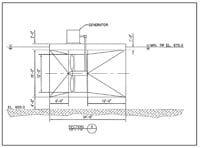
FERC Approves First River-Powered Hydrokinetic Project
The Federal Energy Regulatory
Commission (FERC) has approved the first installation of a hydrokinetic device at an existing
FERC-licensed hydroelectric project, to be located on the Mississippi River in
Hastings, Minn.
Hydrokinetic devices generate electricity from waves or directly from the flow of water in ocean currents, tides or inland waterways. This marks the first time that FERC has approved the installation of a hydrokinetic device at an existing project, where it will generate power into the nation’s electricity grid. The licensee for the existing project, the City of Hastings, plans to install two 35-kilowatt hydrokinetic units suspended below a floating barge in the tailrace of the dam. The hydrokinetic units would have an average annual generation of 364 megawatt-hours.
“Today’s decision is an exciting one for everyone because it combines the use of innovative hydrokinetic technology with a conventional hydropower dam,” FERC Chairman Joseph T. Kelliher said. “This is a creative solution to meeting electricity demand using renewable resources, and I congratulate the City of Hastings for moving forward with the idea.”
“I am thrilled to support today's historic order that allows for harnessing more power from the Mississippi River,” FERC Commissioner Philip Moeller said. “I commend the City of Hastings and the federal agencies that approved this innovative approach toward developing more renewable electricity. I hope this is the first of thousands of similar projects that produce clean and renewable power from in-stream flows at existing dams.”
While this all sounds rosey, there remain major problems with this project and the technology in general. Most significantly, the project will lose money. According to FERC, the project would actually cost the power company $61,700 ($169.45/MWh) annually to operate. Secondly, this form of hydrokinetic technology is likely inconsistent with public recreation. The project is cleverly sited in a public exclusion zone at the base of an Army Corps of Engineers dam, so the project likely will have few or no impacts on river-based recreation. If indeed there are "thousands of similar projects" eventually built in rivers however, the recreational impacts could be huge.
AW is supportive of testing hydrokinetic projects and we hope that the technology will be responsibly sited and operated only in cases in which the environment and public uses will be protected. We are actively involved with the Hastings Project and at a national level to assure that the deployment of this technology does not impact rivers or our enjoyment of them.
